Bill Loguidice's Blog, page 124
March 4, 2015
Videogame documentary “Gameplay” screening exclusively one time on Twitch TV as part of PAX East on Friday 3/6 at 6PM EST
Twitch Movie Night returns at #PAXEast2015 with the live premiere of our feature film documentary, Gameplay: The Story of the Videogame Revolution, this Friday at 6PM EST only on http://twitch.tv/twitch . Be sure to check it out and let us know what you think!
What is Gameplay? Gameplay is a feature film documentary on the history of videogames. Almost 5 years in the making, the film spans the medium’s humble origins to its blockbuster future. From Pong to Pac-Man, Super Mario to Lara Croft, Doom, Grand Theft Auto and beyond, we chronicle the remarkable story of the fastest evolving new media of all time. The film features never seen before interviews with such videogame pioneers as Nolan Bushnell, David Crane, Noah Falstein, John Romero, Todd Howard, and many more, plus all of the iconic and groundbreaking games of the past six decades, tied together with original animation and graphics.
Finally, don’t forget that the exclusive digital engagement on Vimeo On Demand will run through March 19, 2015, after which the film’s availability on other platforms will be announced.
March 2, 2015
Lightning Supplies Certified Lightning Cable Review
 You’d be right to think there wouldn’t be much to say about a third party lightning cable for Apple iPhone 5 and newer devices (which of course includes recent iPads). That’s because the questions about what makes a good cable are simple.
You’d be right to think there wouldn’t be much to say about a third party lightning cable for Apple iPhone 5 and newer devices (which of course includes recent iPads). That’s because the questions about what makes a good cable are simple.
Is it high quality?
Does it both charge and sync?
Is it recognized as a supported accessory?
Does it fit through the vast majority of cases?
Does the manufacturer stand behind their product?

How the Lightning Supplies Certified Lightning Cable comes packaged.
In that regard, the Lightning Supplies Certified Lightning Cable answers all of those questions with a resounding “yes,” and then some. The then some is a sub-$10 price for 3 feet of cable and a lifetime replacement warranty. That’s a value proposition that few, if any other third party cables can match.

The Lightning Supplies Certified Lightning Cable is designed to work with the vast majority of cases. I actually had to previously modify my case (you can probably see where I cut) because I was using a different third party cable that didn’t fit!
Special thanks to Lightning Supplies for providing the review product.
March 1, 2015
Beotto CableButton Cable Management System Review
 “Hi, my name is Bill Loguidice and I have a cable management problem.” (I’ll assume you said “Hi, Bill,” in response in your most sincere sounding voice.) Fortunately, I know I’m not alone. Until the (for now) science fiction future of wireless everything mated to lifetime batteries, cables and their tendency to get in the way are going to continue being a way of modern life. That’s why a product like Beotto’s CableButton cable management system is so handy.
“Hi, my name is Bill Loguidice and I have a cable management problem.” (I’ll assume you said “Hi, Bill,” in response in your most sincere sounding voice.) Fortunately, I know I’m not alone. Until the (for now) science fiction future of wireless everything mated to lifetime batteries, cables and their tendency to get in the way are going to continue being a way of modern life. That’s why a product like Beotto’s CableButton cable management system is so handy.

The front of the CableButton package.
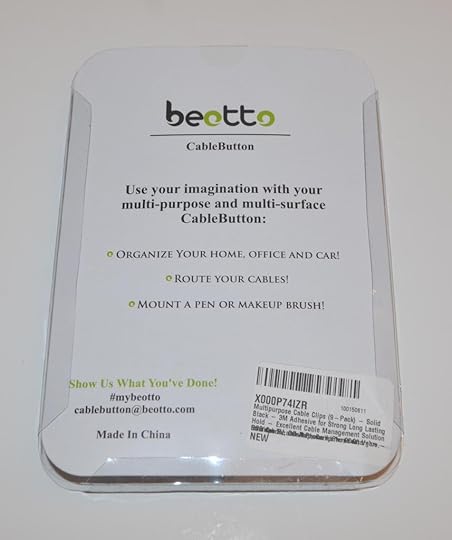
The back of the CableButton package.
The CableButton is a pack of nine rubbery black blobs with cable cavities. These cavities can easily hold a standard size USB cable thickness or two slightly thinner gauge cables (like speaker or headphone wires). The adhesive on the back of the blob keeps it in place, be it mounted horizontally or vertically on a surface. Since the adhesive is 3M brand, when you’re ready to remove the blob, it comes right off and shouldn’t damage most surfaces when doing so.
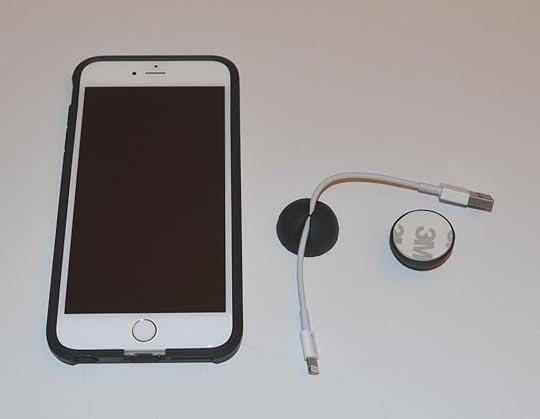
A sample view of the CableButton in use and size comparison with the Apple iPhone 6 Plus.
When you place a cable in the slot, it makes a satisfying click and stays in place without being difficult to take right back out. This is a simple, low cost product that serves a real purpose and does its job well.
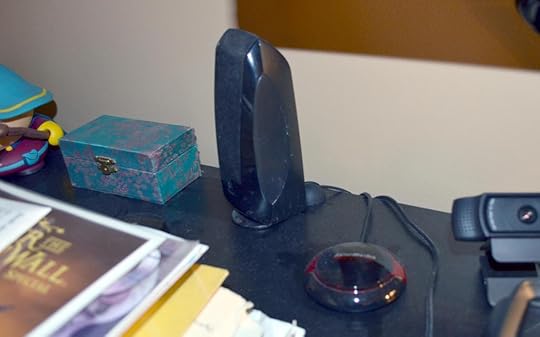
The CableButton is great for keeping my speakers in place on my standing desk.
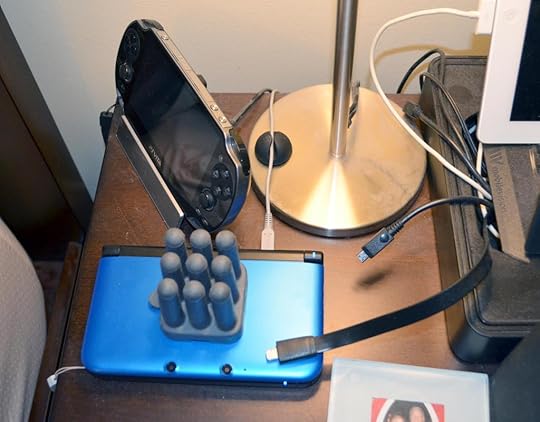
The CableButton does a great job keeping the charging cable attached to my Nintendo 3DS XL on my nightstand. Note that rubbery grey thing on top of the 3DS XL. That was my prior cable management solution I got from a Kickstarter. The CableButton is better.
February 28, 2015
Lifeguard MINI 1 Portable Charger Power Bank Review
 The market is saturated with portable power banks. While these are usually designed specifically for smartphones, such devices can also provide power to just about any other device that can be powered over USB within their specifications, including videogame controllers or wireless headsets. The main challenge with sorting through all of the options is to find the right balance of quality, power, and size. The +LIFEGUARD MINI 1 is one such device. Since cumbersome names seem to be a hallmark of these types of devices, henceforth I will refer to this particular option by the simpler “Lifeguard Mini.”
The market is saturated with portable power banks. While these are usually designed specifically for smartphones, such devices can also provide power to just about any other device that can be powered over USB within their specifications, including videogame controllers or wireless headsets. The main challenge with sorting through all of the options is to find the right balance of quality, power, and size. The +LIFEGUARD MINI 1 is one such device. Since cumbersome names seem to be a hallmark of these types of devices, henceforth I will refer to this particular option by the simpler “Lifeguard Mini.”
The diminutive Lifeguard Mini provides 3000mAh capacity from its Samsung battery (which is rated for more than 800 recharges) with a 5V 1A output. As a point of reference, the 3000mAh battery is slightly higher capacity than that found in large phones like the Apple iPhone 6 Plus and slightly lower capacity than that found in the Samsung Galaxy Note 3. That means that even the largest phone can usually be charged to at or near its full capacity within 1.5 to 2.5 hours. A helpful indicator light provides charge status.

Lifeguard Mini size comparison versus an Apple iPhone 6 Plus.
The Lifeguard Mini comes bundled with the device, a manual, and two 5.9″ mini cables: a standard micro USB cable that both charges the Lifeguard Mini itself and can also be used for any other micro USB device (like most Android devices, or devices like the Sony PlayStation 4 controller, which I used for testing) to connect to the Lifeguard Mini, as well as a lightning cable that can both charge and sync (the latter when connected to a computer) for Apple iPhone 5 or newer devices (it works great with my iPhone 6 Plus).
The attractive aluminum shell, available in a variety of colors (mine is Navy Blue), helps with accidental drops, while the 18-month money-back warranty should provide additional peace of mind. From its professional packaging to the quality and size of the device itself, I have no hesitation in recommending the Lifeguard Mini if you’re in the market for a portable power source.
StrapSnake Cotton Guitar Strap Review
 As technology enthusiasts, we often focus on the primary technology to the exclusion of most everything else. What I mean by this is that we’ll carefully research and then purchase, say, an expensive mobile device costing hundreds of dollars, then cheap out on a $5 case or charging cable. Musical instruments are no different. Even starter electric guitars cost a pretty penny, but then we’ll just use any old strap to place it on our bodies each and every time we’re playing the thing. That was my situation with my Epiphone Les Paul Junior guitar that came with my Sony PlayStation 3 version of the original Rocksmith from Ubisoft, which I got back in late 2011.
As technology enthusiasts, we often focus on the primary technology to the exclusion of most everything else. What I mean by this is that we’ll carefully research and then purchase, say, an expensive mobile device costing hundreds of dollars, then cheap out on a $5 case or charging cable. Musical instruments are no different. Even starter electric guitars cost a pretty penny, but then we’ll just use any old strap to place it on our bodies each and every time we’re playing the thing. That was my situation with my Epiphone Les Paul Junior guitar that came with my Sony PlayStation 3 version of the original Rocksmith from Ubisoft, which I got back in late 2011.

My original RockSmith strap.

How the StrapSnake strap arrived.
While I’m still a complete guitar newbie thanks to my lack of time to practice, I’m now trying to stumble my way through Rocksmith 2014 on the PC. It was therefore good timing that I received a review unit of StrapSnake’s cotton guitar strap. There was nothing wrong with the Rocksmith-branded strap that came with my guitar, but I will say it was also nothing to take note of. It was a functional, if stiff, strap. Assuming that was what they were all more or less like, I thought nothing more of it.

The StrapSnake guitar strap.

The Rocksmith strap (left) versus the StrapSnake strap (right).
Grabbing the StrapSnake strap, I immediately noticed the difference. I honestly don’t know what material the Rocksmith strap is made from, but it was nowhere near as supple as the StrapSnake strap. Whatever the material differences, the StrapSnake model is clearly a step up in nearly all areas of its design. While I’m not someone you should take musical advice from, I do know what good design is. The StrapSnake is good design.
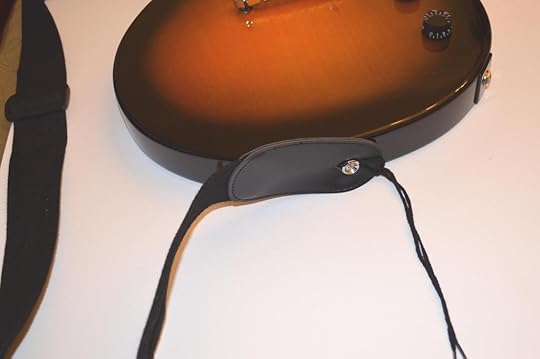
As you would expect, the StrapSnake attaches easily.
In regard’s to the StrapSnake‘s specs, I imagine they’re pretty standard. It easily fit on my electric guitar and is said to work on acoustic models as well, which I didn’t test (I only have one other electric guitar and an acoustic ukelele). The strap itself adjusts from 33.5″ to 56″. I like my straps shorter, but as you can tell from the photos, there’s a lot of room for adjustment.

Your review author “rocking out” with the StrapSnake guitar strap.
A guitar strap is not necessarily something to obsessively research, but it is something that you’ll constantly make use of and is therefore worth investing in a decent one. The StrapSnake is a good one and has a nice bonus of having no brand markings on it, unlike my previous Rocksmith strap which loudly advertised the brand of the product I was already using.
February 26, 2015
Switch Galaxy Ultra (PS4/PS Vita) Review
Atomicom’s Switch Galaxy Ultra is a futuristic, track hopping race-against-the-clock and collect-em-up for the Sony PlayStation 4 (PS4) and Vita, which was released on December 17, 2014, in Europe, and February 24, 2015, in North America. I’ll be reviewing the North American version on both platforms.

Switch Galaxy Ultra on the PS4
Both versions of the game are locked down to a smooth 60 Frames Per Second (FPS), with the PS4 version sporting full 1080p resolution. Regardless of whether you own a PS4 or Vita (or both), it’s a Cross-Buy game, meaning that you buy it once on either platform and you own the game on both. As expected, there’s also a discount on the purchase price if you’re a PlayStation Plus member (and if you own a PS3, PS4, and/or Vita, it would be silly not to be). Most other PlayStation-specific features are supported, including Cross-Play, Cloud-Save, and two modes of Online Multiplayer with leaderboards.

Switch Galaxy Ultra on the Vita
For a game clearly inspired by classic action games, the back story is suitably straightforward. You play as Vince Vance, one of the last remaining humans and one of Dakur’s best pilots. Head of Dakur Technology, Amur Ness, has tasked you with going out into the galaxy and collecting the valuable element tantalum, which allows you to travel been cities (the courses).

Switch Galaxy Ultra on the PS4
There are 55 levels featuring elements like speeds-ups, teleports, jumps, enemy ships, and bombs. You can earn credits as you play to unlock a total of six new ships with upgradeable skins and stats.

Switch Galaxy Ultra on the Vita
The track designs remind me a bit of Hewson’s multi-platform classic, Eliminator (1988; I played the Commodore Amiga version the most), while the art aesthetic, from the ships to the backgrounds, are unmistakably inspired by Psygnosis’s legendary multi-platform Wipeout (1995 and beyond) series. This is no coincidence, as Switch Galaxy Ultra‘s cities were designed by Wipeout‘s cro-creator, Jim Bowers, and you’ll also be able to unlock digital comic content featuring seven mini episodes of Vince’s travels around the galaxy that were designed by Wipeout‘s original concept artist, Darren Douglas.
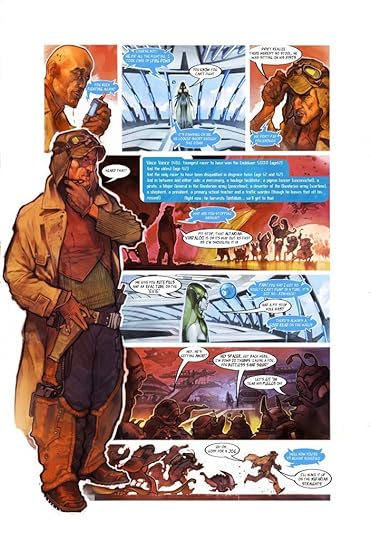
Switch Galaxy Ultra sample digital comic page. On each system, the individual comic panels are zoomed in for easier viewing.
While there are no instructions for the game anywhere that I could find, there is a helpful in-game tutorial (I’d be shocked if the female voice actor giving the instructions wasn’t the same as Adventure Time‘s BMO!). Even without the tutorial, the controls are simple enough to master. Your ship, which you steer with either the d-pad or left analog stick (the left and right bumpers can also be used to change lanes), is constantly in motion. When you start to fill your boost gauge, press the X button to use it. To brake, press the circle button. The basic goal is to stay on any of the available tracks, avoiding missing portions (gaps) and other obstacles. Once you make it safely through a portion of the track, you’ll enter a wormhole, where your ship can move freely to collect as many tantalum orbs as you’re able to before returning to said track. The faster you make it through a course, the more credits you’ll earn for ship upgrades. When you’re back at the map screen, you can then spend tantalum orbs to compete at additional cities/courses.
Fortunately, for when you don’t feel like dealing with things like choosing courses and ship management in the main campaign, there’s also an almost Zen-like game mode called Survival that lets you simply race – until you run into something – for a high score and credits. Unfortunately, since it’s such a new game here in North America, I was unable to find an online multiplayer game to test that functionality in time for this review. Whether that mode proves worthwhile depends of course on how popular the game becomes, but it’s not something I’d necessarily count on being a go-to option.
While I would have liked a slightly greater sense of speed, visually the game is undeniably a looker with superb draw distance and the aforementioned frame rate keeping the action buttery smooth. Audio is dominated by a take-it-or-leave-it high energy techno soundtrack that seems par for the course for this type of game, with the sparse sound effects very much taking a back seat. Either the music or sound effects (or both) can be toggled off in the Main Menu’s Options.
While some may find there’s too little to do in this game, I think there’s an audience out there like me who will appreciate the simplicity in its design that harkens back to the more immediate gratification of vintage videogames. There are few controls to learn and its progression system is straightforward and logical. This is a game for those who like challenges and a “just one more play” vibe without unnecessary design layers or frustration that just a little more practice can’t overcome.
Special thanks to Atomicom for the review code.
February 4, 2015
Videogame feature film documentary, Gameplay, now exclusively online at Vimeo On Demand
Our feature film documentary, Gameplay: The Story of the Videogame Revolution, is now available exclusively from Vimeo On Demand for rent or purchase. Availability is worldwide and subtitles are accessible in English, French, Italian, Spanish (Mexico), Dutch, German, Japanese, and Portuguese (Brazil).
What is Gameplay? Gameplay is a feature film documentary on the history of videogames. Almost 5 years in the making, the film spans the medium’s humble origins to its blockbuster future. From Pong to Pac-Man, Super Mario to Lara Croft, Doom, Grand Theft Auto and beyond, we chronicle the remarkable story of the fastest evolving new media of all time. The film features never seen before interviews with such videogame pioneers as Nolan Bushnell, David Crane, Noah Falstein, John Romero, Todd Howard, and many more, plus all of the iconic and groundbreaking games of the past six decades, tied together with original animation and graphics.
The exclusive engagement on Vimeo On Demand will run through March 19, 2015, after which the film’s availability on other platforms will be announced.
February 1, 2015
Review of Swift-n-Snug Running Belt
If there’s one thing that’s universally true for those of us at Armchair Arcade, it’s that we love our gadgets. As such, we sometimes run into the issue of where to stow those gadgets, particularly when on the move. That’s where something like the Swift-n-Snug Running Belt comes in so handy.

Swift-n-Snug box front. The packaging was a bit crushed in transit, but the belt inside was unharmed.

Swift-n-Snug box rear. The packaging was a bit crushed in transit, but the belt inside was unharmed.
While some may call products like this running belt a fanny pack, that’s giving fanny packs too much credit. Products like the Swift-n-Snug Running Belt are purpose-built belts designed for running, workouts, or any other activity with demanding movements (cleaning inside or outside the house, for instance) where you also need to bring along a wallet, keys, or gadgets like a smartphone. Of course, it also doesn’t hurt that belts like this look like high performance sporting equipment rather than the stereotypical socially-derided fanny pack design.
My first experience with a running belt was with the SPIbelt Sports/Running Belt. I appreciated that belt’s functionality. I’m not a runner, but I do work out at a gym at least five days a week. Whether it’s lifting weights or doing cardio, if I’m not wearing shorts or pants with pockets, or I’m going to do activities where having something in my shorts or pants that do have pockets would be cumbersome, I wear this type of belt. With the SPIbelt, I used it with my HTC One M8 smartphone (with case), and it fit that large phone well. Since I have an iPhone 6 Plus now (with case), that’s what I’m putting inside my Swift-n-Snug belt. While the generous size of the iPhone 6 Plus does stretch the pocket to its limits, it still fits.

When you first take the Swift-n-Snug out of the packaging, be sure to remove the pull tab on the battery compartment so the light can work.
It’s important to keep in mind that running belts are supposed to hold their cargo securely, so there are no holes to run headphone wires out of the zippered pocket. While you can slightly unzip the pocket and run the headphone wire out that way, it’s best just to do what many of us who work out do these days and go wireless. I happen to use the Avantree Jogger Pro for when I listen to podcasts or music at the gym since it’s comfortable and secure with great battery life (and decent audio quality) and let’s me control my players’ remotely, but obviously any good bluetooth headset will do.
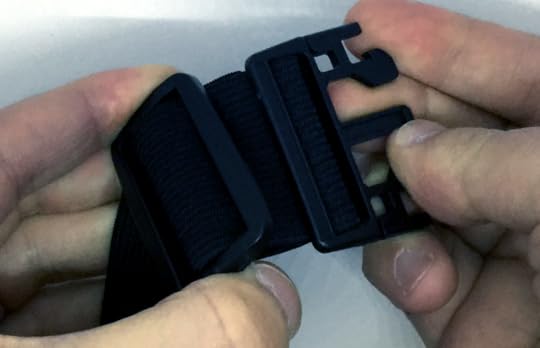
The sliding clip makes adjusting for various waist sizes and clothing thicknesses easy.
The Swift-n-Snug belt is fully adjustable for waist sizes up to 44″ using its sliding clip. As such, it fit my ~36″ waist just fine once I made a minor adjustment. I recommend that you use these running belts over clothing rather than under so there’s no chance of chafing against your skin.

The Swift-n-Snug with the light in the on position.
While the Swift-n-Snug belt only comes in one color scheme, black with some yellow, it does have a unique feature, a light that’s activated by pressing the button on the black and yellow oval. One press of the button creates a solid yellow light around the pouch, a second press flashes the light quickly, and a third press flashes the light slowly, with the fourth press turning the light back off. While this is not particularly useful for working out indoors like I do most of the time, this is certainly a great safety feature for running or walking outdoors in low light conditions. The batteries are the usual CRS2032 button cells, of which you’ll need two replacements once these go, but that should only be after many hours of use.

The Swift-n-Snug can fit several small items in its pouch, but if you have a particularly large smartphone, like an iPhone 6 Plus (in a case), then that’s probably near its limits.
I received this Swift-n-Snug belt as a review unit, and the communication with the Swift-n-Snug company rep has been excellent throughout the whole process. While I had no opportunity to contact customer service or take advantage of the lifetime money back guarantee, it does bode well in case an issue does ever arise. Frankly, the only failure point I can really think of is the light, and even that is designed and integrated so well into the belt I can’t see an issue being very likely.
For those wondering about arm/sports bands instead of this, frankly I don’t like them. They don’t stay well on my upper arm and I don’t like compression in that area when I’m working out, particularly when doing any type of upper body work. The waist area really is superior for this type of thing.

The Swift-n-Snug can be placed in various locations on the waist. Here it is holding my iPhone 6 Plus (with case).
January 7, 2015
Armchair Arcade gets first new logo in over four years
Since launching the new Armchair Arcade Website on October 22, 2014, after two previous versions dating back to 2003 and 2006, respectively, I thought it high time that our logo get a much needed update as well for 2015 and beyond. If you recall, these were just a few of our prior logos:

Logo, circa 2013
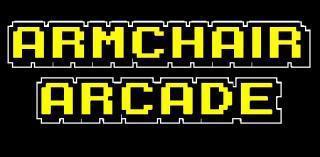
Logo, circa 2006

Logo, 2005
Here is the new primary logo:
Here is the new secondary logo:
Thanks as always for the support!
January 6, 2015
Videogame documentary “Gameplay” now on Vutopia through February 6, 2015
Our feature film documentary, Gameplay: The Story of the Videogame Revolution, in partnership with Gravitas Ventures, is now running exclusively on Vutopia through February 6, 2015.

Now playing!
Vutopia is the movie lover’s ultimate destination. It’s all of your favorite movies On Demand, available to watch on TV and online, anytime you want. Vutopia offers many movies including Hollywood favorites, indie movies and documentaries, with new movies premiering each month. It’s a movie for every mood in cool categories that make the search as fun as the find. Vutopia is your movie happy place.
Vutopia is currently available as a part of Movie Pass from Time Warner Cable and Bright House Networks.
Gameplay: The Story of the Videogame Revolution is a feature documentary film on the history of videogames. Almost five years in the making, the film spans the industry’s origins and beyond as it chronicles the remarkable story of the fastest evolving new media of all time.
The film features never seen before interviews with such videogame pioneers as Nolan Bushnell, David Crane, Noah Falstein, John Romero, Todd Howard, and many more, plus all of the iconic and groundbreaking games of the past 50 years or so, all tied together with original animation and graphics.
A press release and information on additional showings will follow.
Vutopia‘s Gameplay trailer:
The original Gameplay trailer:





